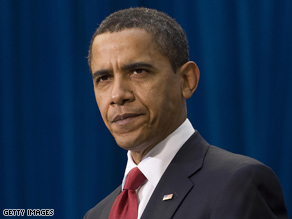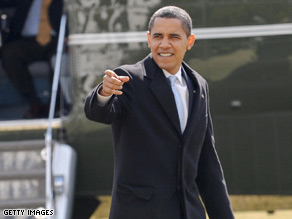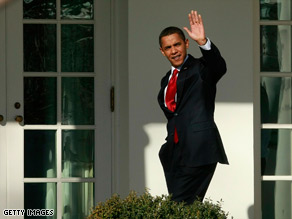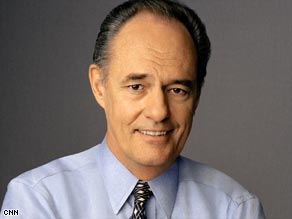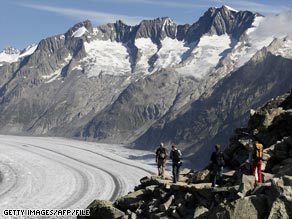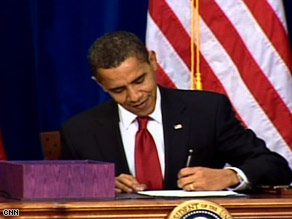
President Obama signed the $787 economic stimulus bill Tuesday in Denver, Colorado. Here is a full transcript of his remarks.
President Obama: It is great to be in Denver. I was here last summer to accept the nomination of my party and to make a promise to people of all parties that I would do all I could to give every American the chance to make of their lives what they will and see their children climb higher than they did. I am back today to say that we have begun the difficult work of keeping that promise. We have begun the essential work of keeping the American dream alive in our time. Today does not mark the end of our economic troubles. Nor does it constitute all of what we must do to turn our economy around. But it does mark the beginning of the end — the beginning of what we need to do to create jobs for Americans scrambling in the wake of layoffs, to provide relief for families worried they won’t be able to pay next month’s bills and to set our economy on a firmer foundation, paving the way to long-term growth and prosperity. iReport.com: Stimulus thoughts: What would you fix first The American Recovery and Reinvestment Act that I will sign today, a plan that meets the principles I laid out in January, is the most sweeping economic recovery package in our history. It is the product of broad consultations — and the recipient of broad support — from business leaders, unions and public interest groups, the Chamber of Commerce, the National Association of Manufacturers, Democrats and Republicans, mayors as well as governors.
Don’t Miss
Cafferty: Stimulus bill a sorry spectacle
Gergen: Obama faces growing economic storms
Solar-power firm fired up about stimulus
It is a rare thing in Washington for people with such different viewpoints to come together and support the same bill, and on behalf of our nation, I thank them for it, including your two outstanding new senators, Michael Bennet and Mark Udall. I also want to thank my vice president, Joe Biden, for working behind the scenes from the very start to make this recovery act possible. I want to thank Speaker Pelosi and Harry Reid for acting so quickly and proving that Congress could step up to this challenge. I want to thank Max Baucus, chairman of the Finance Committee, without whom none of this would have happened. And I want to thank all the committee chairs and members of Congress for coming up with a plan that is both bold and balanced enough to meet the demands of this moment. The American people were looking to them for leadership, and that is what they provided. What makes this recovery plan so important is not just that it will create or save 3½ million jobs over the next two years, including nearly 60,000 in Colorado. It’s that we are putting Americans to work doing the work that America needs done in critical areas that have been neglected for too long, work that will bring real and lasting change for generations to come. Because we know we can’t build our economic future on the transportation and information networks of the past, we are remaking the American landscape with the largest new investment in our nation’s infrastructure since Eisenhower built an interstate highway system in the 1950s. Because of this investment, nearly 400,000 men and women will go to work rebuilding our crumbling roads and bridges, repairing our faulty dams and levees, bringing critical broadband connections to businesses and homes in nearly every community in America, upgrading mass transit and building high-speed rail lines that will improve travel and commerce throughout the nation. Because we know America can’t outcompete the world tomorrow if our children are being outeducated today, we are making the largest investment in education in our nation’s history. It’s an investment that will create jobs building 21st-century classrooms, libraries and labs for millions of children across America. It will provide funds to train a new generation of math and science teachers while giving aid to states and school districts to stop teachers from being laid off and education programs from being cut. In New York City alone, 14,000 teachers who were set to be let go may now be able to continue pursuing their critical mission. It’s an investment that will create a new $2,500 annual tax credit to put the dream of a college degree within reach for middle class families and make college affordable for seven million students, helping more of our sons and daughters aim higher, reach farther and fulfill their God-given potential. Because we know that spiraling health care costs are crushing families and businesses alike, we are taking the most meaningful steps in years towards modernizing our health care system. It’s an investment that will take the long overdue step of computerizing America’s medical records, to reduce the duplication and waste that costs billions of health care dollars and the medical errors that every year cost thousands of lives. Further, thanks to the action we have taken, 7 million Americans who lost their health care along with their jobs will continue to get the coverage they need, and roughly 20 million more can breathe a little easier, knowing that their health care won’t be cut due to a state budget shortfall. And an historic commitment to wellness initiatives will keep millions of Americans from setting foot in the doctor’s office for purely preventable diseases. Taken together with the enactment earlier this month of a long-delayed law to extend health care to millions more children of working families, we have done more in 30 days to advance the cause of health reform than this country has done in a decade. Because we know we can’t power America’s future on energy that’s controlled by foreign dictators, we are taking a big step down the road to energy independence and laying the groundwork for a new green energy economy that can create countless well-paying jobs. It’s an investment that will double the amount of renewable energy produced over the next three years and provide tax credits and loan guarantees to companies like Namaste Solar, a company that will be expanding, instead of laying people off, as a result of the plan I am signing. In the process, we will transform the way we use energy. Today, the electricity we use is carried along a grid of lines and wires that dates back to Thomas Edison, a grid that can’t support the demands of clean energy. This means we’re using 19th- and 20th-century technologies to battle 21st-century problems like climate change and energy security. It also means that places like North Dakota can produce a lot of wind energy but can’t deliver it to communities that want it, leading to a gap between how much clean energy we are using and how much we could be using. The investment we are making today will create a newer, smarter electric grid that will allow for the broader use of alternative energy. We will build on the work that’s being done in places like Boulder, Colorado, a community that is on pace to be the world’s first Smart Grid city. This investment will place Smart Meters in homes to make our energy bills lower, make outages less likely and make it easier to use clean energy. It’s an investment that will save taxpayers over $1 billion by slashing energy costs in our federal buildings by 25 percent and save working families hundreds of dollars a year on their energy bills by weatherizing over 1 million homes. And it’s an investment that takes the important first step towards a nationwide transmission superhighway that will connect our cities to the windy plains of the Dakotas and the sunny deserts of the Southwest. Even beyond energy, from the National Institutes of Health to the National Science Foundation, this recovery act represents the biggest increase in basic research funding in the long history of America’s noble endeavor to better understand our world. Just as President Kennedy sparked an explosion of innovation when he set America’s sights on the moon, I hope this investment will ignite our imagination once more, spurring new discoveries and breakthroughs that will make our economy stronger, our nation more secure and our planet safer for our children. While this package is mostly composed of critical investments, it also includes aid to state and local governments to prevent layoffs of firefighters or police recruits — recruits like the ones in Columbus, Ohio, who were told that instead of being sworn in as officers, they would be let go. It includes help for those hardest hit by our economic crisis, like the nearly 18 million Americans who will get larger unemployment checks in the mail. And about a third of this package comes in the form of tax cuts — the most progressive in our history — not only spurring job creation but putting money in the pockets of 95 percent of all hardworking families. Unlike tax cuts we’ve seen in recent years, the vast majority of these tax benefits will go not to the wealthiest Americans but to the middle class, with those workers who make the least benefiting the most. And it’s a plan that rewards responsibility, lifting 2 million Americans from poverty by ensuring that anyone who works hard does not have to raise a child below the poverty line. As a whole, this plan will help poor and working Americans pull themselves into the middle class in a way we haven’t seen in nearly 50 years. What I am signing, then, is a balanced plan with a mix of tax cuts and investments. It is a plan that’s been put together without earmarks or the usual pork-barrel spending. And it is a plan that will be implemented with an unprecedented level of transparency and accountability. Watch Obama tout plan’s balance With a recovery package of this scale comes a responsibility to assure every taxpayer that we are being careful with the money they work so hard to earn. That’s why I am assigning a team of managers to ensure that the precious dollars we have invested are being spent wisely and well. We will hold the governors and local officials who receive money to the same high standards. And we expect you, the American people, to hold us accountable for the results. That is why we have created Recovery.gov, so every American can go online and see how their money is being spent. As important as the step we take today is, this legislation represents only the first part of the broad strategy we need to address our economic crisis. In the coming days and weeks, I will be launching other aspects of the plan. We will need to stabilize, repair and reform our banking system and get credit flowing again to families and businesses. We will need to end a culture where we ignore problems until they become full-blown crises instead of recognizing that the only way to build a thriving economy is to set and enforce firm rules of the road. We must stem the spread of foreclosures and falling home values for all Americans and do everything we can to help responsible homeowners stay in their homes, something I will talk more about tomorrow. And while we need to do everything in the short-term to get our economy moving again, we must recognize that having inherited a trillion-dollar deficit, we need to begin restoring fiscal discipline and taming our exploding deficits over the long-term. None of this will be easy. The road to recovery will not be straight and true. It will demand courage and discipline and a new sense of responsibility that has been missing, from Wall Street to Washington. There will be hazards and reverses along the way. But I have every confidence that if we are willing to continue doing the difficult work that must be done — by each of us and by all of us — then we will leave this struggling economy behind us, and come out on the other side, more prosperous as a people.
For our American story is not — and has never been — about things coming easy. It’s about rising to the moment when the moment is hard, converting crisis into opportunity and seeing to it that we emerge from whatever trials we face stronger than we were before. It’s about rejecting the notion that our fate is somehow written for us, and instead laying claim to a destiny of our own making. That is what earlier generations of Americans have done, and that is what we are doing today. Thank you.
